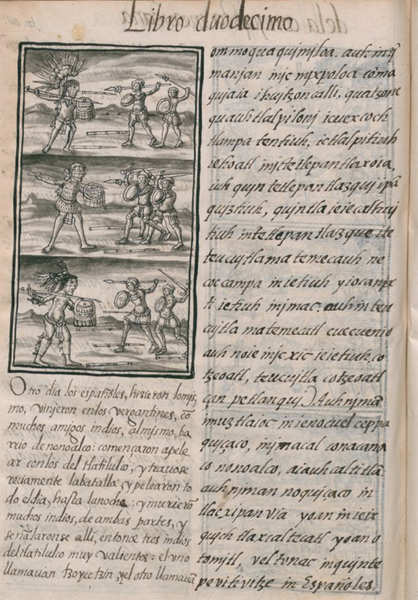Folio 60 verso
Translations and Transcriptions
Spanish Translation
[Translation of the Nahuatl into Spanish by Fr. Bernardino de Sahagún; transcription of the Spanish (left-hand column) by James Lockhart:] [f. 60v.] Otro dia los españoles, hizieron lo mismo, vinieron en los vergantines, cō muchos amigos indios, al mismo barrio de nonoalco: començaron a pelear con los del tlatilulco, y trauose reciamente la batalla, y pelearon todo el dia, hasta la noche: y murierō muchos indios, de ambas partes, y señalaronse alli, entonce tres indios del tlatilulco muy valientes: el vno llamauan tzoyectzin, y el otro llamauā
English Translation
[Translation of the Nahuatl (right-hand column) by James Lockhart:] to disguise himself he put on a feather hairpiece or wig, with eagle feathers tied at the back of the neck. This was the way that those who threw people in the fire were attired; he went about looking like one of them, imitating them. He had golden arm bands on both sides, on both arms, shimmering, and he also had shining golden bands on the calves of his legs.) Then the next day they came again and grounded their boats at Nonoalco, at Ayauhcaltitlan. Also those who go on foot and all the Tlaxcalans and Otomis came, a great abundance of them. The Spaniards came herding them ahead of them. [Translation of the Spanish (left-hand column) by James Lockhart:] The next day the Spaniards did the same thing; they came in the brigantines with many Indian friends to the same district of Nonoalco. They began to fight with the Tlatelolca; the battle was fierce, and they fought all day long until night. Many Indians died on both sides. Three very valiant Indians of Tlatelolco distinguished themselves there at that time: the one called Tzoyectzin, another called
Analytic Transcription
[Transcription of the Nahuatl (right-hand column) by James Lockhart:] [f. 60v.] ommoquaquimiloa, auh in q̄manian inic mixpoloa cōmaquiaia ihuitzoncalli, quatzone quauhtlalpiloni icuexcochtlampa tentiuh, ic tlalpitiuh iehoatl inic tetlepantlaxoia, iuhquin tetlepantlazqui ipā quiztiuh, quintlaieiecalhuitiuh in tetlepantlazque iteteucuitlamatemecauh necoccampa in ietiuh yiocanixti ietiuh in imac: auh in teucuitlamatemecatl cuecuenio auh no ie in icxic ieietiuh, cotzeoatl, teucuitlacotzeoatl çan petlanqui.) Auh nīma imuztlaioc in ie no cuel ceppa quiçaco in imacal conacanaco nonoalco, aiauhcaltitlā: auh niman no quiçaco in tlacxipanvia yoan in ie ixquich tlaxcaltecatl yoan otomitl, vel tonac in quintepevitivitze in Españoles.
Image

Spanish Translation
[Translation of the Nahuatl into Spanish by Fr. Bernardino de Sahagún; transcription of the Spanish (left-hand column) by James Lockhart:] [f. 60v.] Otro dia los españoles, hizieron lo mismo, vinieron en los vergantines, cō muchos amigos indios, al mismo barrio de nonoalco: començaron a pelear con los del tlatilulco, y trauose reciamente la batalla, y pelearon todo el dia, hasta la noche: y murierō muchos indios, de ambas partes, y señalaronse alli, entonce tres indios del tlatilulco muy valientes: el vno llamauan tzoyectzin, y el otro llamauā
English Translation
[Translation of the Nahuatl (right-hand column) by James Lockhart:] to disguise himself he put on a feather hairpiece or wig, with eagle feathers tied at the back of the neck. This was the way that those who threw people in the fire were attired; he went about looking like one of them, imitating them. He had golden arm bands on both sides, on both arms, shimmering, and he also had shining golden bands on the calves of his legs.) Then the next day they came again and grounded their boats at Nonoalco, at Ayauhcaltitlan. Also those who go on foot and all the Tlaxcalans and Otomis came, a great abundance of them. The Spaniards came herding them ahead of them. [Translation of the Spanish (left-hand column) by James Lockhart:] The next day the Spaniards did the same thing; they came in the brigantines with many Indian friends to the same district of Nonoalco. They began to fight with the Tlatelolca; the battle was fierce, and they fought all day long until night. Many Indians died on both sides. Three very valiant Indians of Tlatelolco distinguished themselves there at that time: the one called Tzoyectzin, another called
Analytic Transcription
[Transcription of the Nahuatl (right-hand column) by James Lockhart:] [f. 60v.] ommoquaquimiloa, auh in q̄manian inic mixpoloa cōmaquiaia ihuitzoncalli, quatzone quauhtlalpiloni icuexcochtlampa tentiuh, ic tlalpitiuh iehoatl inic tetlepantlaxoia, iuhquin tetlepantlazqui ipā quiztiuh, quintlaieiecalhuitiuh in tetlepantlazque iteteucuitlamatemecauh necoccampa in ietiuh yiocanixti ietiuh in imac: auh in teucuitlamatemecatl cuecuenio auh no ie in icxic ieietiuh, cotzeoatl, teucuitlacotzeoatl çan petlanqui.) Auh nīma imuztlaioc in ie no cuel ceppa quiçaco in imacal conacanaco nonoalco, aiauhcaltitlā: auh niman no quiçaco in tlacxipanvia yoan in ie ixquich tlaxcaltecatl yoan otomitl, vel tonac in quintepevitivitze in Españoles.
Image
